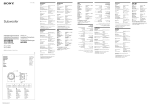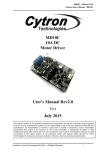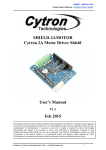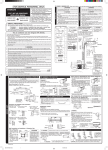Download UNIVERSITI TEKNOLOGI MALAYSIA
Transcript
PSZ 19:16 (Pind. 1/07) UNIVERSITI TEKNOLOGI MALAYSIA DECLARATION OF THESIS / UNDERGRADUATE PROJECT PAPER AND COPYRIGHT EFEDI BI AWAG Author’s full name : 29 OVEMBER 1985 Date of birth : Title : SMART TRAFFIC LIGHT FOR EMERGECY VEHICLES Academic Session: 2007/2008 I declare that this thesis is classified as : CONFIDENTIAL (Contains confidential information under the Official Secret Act 1972)* RESTRICTED (Contains restricted information as specified by the organisation where research was done)* OPEN ACCESS I agree that my thesis to be published as online open access (full text) I acknowledged that Universiti Teknologi Malaysia reserves the right as follows : 1. The thesis is the property of Universiti Teknologi Malaysia. 2. The Library of Universiti Teknologi Malaysia has the right to make copies for the purpose of research only. 3. The Library has the right to make copies of the thesis for academic exchange. Certified by : SIGNATURE 851129-11-5593 (NEW IC NO. /PASSPORT NO.) Date : NOTES : 13 MAY 2008 * SIGNATURE OF SUPERVISOR DR. HAZLIA BT SELAMAT NAME OF SUPERVISOR Date : 13 MAY 2008 If the thesis is CONFIDENTIAL or RESTRICTED, please attach with the letter from the organisation with period and reasons for confidentiality or restriction. “I hereby declare that I have read this thesis and in my opinion this thesis is sufficient in terms of scope and quality for the award of the degree of Bachelor of Electrical Engineering (Control & Instrumentation)” Signature : ……………………........................ Name of Supervisor : DR. HAZLINA BINTI SELAMAT Date : 13th MAY 2008 SMART TRAFFIC LIGHT FOR EMERGENCY VEHICLES EFENDI BIN AWANG A report submitted in partial fulfilment of the requirements for the award of the degree of Bachelor of Electrical Engineering (Control & Instrumentation) Faculty of Electrical Engineering Universiti Teknologi Malaysia MAY 2008 I declare that this thesis entitled “ Smart Traffic Light for Emergency Vehicles” is the result of my own research except as cited in the references. The thesis has not been accepted for any degree and is not concurrently submitted in candidature of any other degree. Signature : ...................................... Name : EFENDI BIN AWANG Date : 13 MAY 2008 iii To my beloved mother (Mek binti Embong), father (Awang bin Othman), and family members iv ACKNOWLEDGEMENT Alhamdulillah, thanks to Almighty ALLAH S.W.T for give me a chance to complete this thesis. All good aspirations, devotions, and prayers are due to ALLAH whose blessing and guidance have helped me throughout to entire project. Firstly, I would like to take this opportunity to express my appreciation to my supervisor Dr. Hazlina binti Selamat, who are really talented in the instrumentation field. My supervisor supported me in the way that they were giving help and encouragement to encounter new challenge in final year project. Her knowledge and advice have been of great value for me. Not forgetting also, a word of thanks to Encik Mohamad Syukri bin Abdul Manaf for his guidance in Programmable Logic Controller (PLC). Besides, thanks to all PSM committee because of their useful information. Then, I would like to thanks to University Teknologi Malaysia department for give me a chance to register in final year project subject. Then, I would like to thank especially to my beloved parents because of their sacrifice and support me in the way to finish this thesis. Thanks also to my sisters, brothers and other families for their loving support. My special thanks go to Adliany and Hudabiyah because of support and help me in the way to finish this thesis. My sincere appreciation also extends to Adillah, Apit, Aizuddin, Sireh, Apat and all my fellow friends of SEI. Their entire companion is truly appreciated, as it was a great pleasure to have known them. v ABSTRACT This project is introducing the application of the PLC nowadays. PLC is a black-white relay controller of logic foundation using Ladder Diagram and Mnemonic codes, with the 3C technology (Computer, Control and Communication) unifies. Programmable Logic Control is important because all production processes go through a fixed repetitive sequence of operations. A PLC is used to control, time and regulate the sequence. In this project, PLC was used to design a T-Junction traffic light. Sensor was used to sense and give priority to emergency vehicles through any junction. The sensor will sense the emergency vehicles and give a signal to PLC to turn on green light for that way. All the red light will turn on for a while when it change from junction to junction as a safety factor. The traffic light will be function follow the sequence from junction to other junction starting from green, yellow and red. Photodiode was used as a sensor. The photodiode sensor will be mounting at the signboard 200 meter from the traffic light. The photodiode sensor will turn on when it sense the emergency vehicles. PLC will receive the signal from the photodiode sensor and will turn on green light at that junction. It means, the traffic light will give priority to emergency vehicles cross the junction. Furthermore, the other junctions turn to red. vi ABSTRAK Projek ini memperkenalkan aplikasi Programmable Logic Controller (PLC) pada masa kini. PLC adalah geganti pengawal hitam putih yang berasaskan logik menggunakan gambarajah tangga dan kod mnemonik dengan menggabungkan teknologi 3C (Computer, Control, Communication). PLC amat penting dalam sesuatu proses kerana ia melibatkan proses yang berturutan untuk membuat sesuatu keputusan. PLC digunakan untuk mengawal, menetapkan masa dan memanipulasi sesuatu turutan. Dalam projek ini, PLC digunakan untuk merekabentuk sistem lampu isyarat lalulintas di simpang tiga. Sistem lampu isyarat tersebut menggunakan pengesan untuk memberi keutamaan kepada kenderaan kecemasan yang melalui mana-mana simpang. Pengesan akan mengesan kenderaan kecemasan dan memberi isyarat kepada PLC untuk menukar aliran lampu isyarat hijau kepada laluan tersebut. Setiap perubahan dari satu simpang ke simpang yang lain, semua lampu merah akan menyala untuk seketika sebagai faktor keselamatan. Lampu isyarat berfungsi mengikut turutan dari simpang ke simpang bermula dari hijau, kuning dan kemudian merah. Pengesan yang digunakan dalam sistem lampu isyarat ini adalah pengesan fotodiod. Pengesan fotodiod dipasang pada palang papan tanda pada jarak 200 meter dari lampu isyarat tersebut. Apabila pengesan mengesan kenderaan kecemasan, ia akan aktif. Pengesan akan memberi isyarat kepada PLC untuk menukar aliran lampu hijau kepada simpang tersebut. Ini bermakna, kenderaan kecemasan akan diberi keutamaan untuk melintas simpang tersebut. Oleh itu, isyarat pada simpang-simpang yang lain akan bertukar menjadi merah. vii TABLE OF CONTENTS CHAPTER 1 2 TITLE PAGE DECLARATION ii DEDICATION iii ACKNOWLEDGEMENT iv ABSTRACT v ABSTRAK vi TABLE OF CONTENTS vii LIST OF FIGURES ix LIST OF TABLE xi LIST OF APPENDICES xii INTRODUCTION 1 1.1 History of Traffic Light 1 1.2 Problem Statement 2 1.3 Objectives 3 1.4 Scope of Work 3 1.5 Outline 4 LITERATURE REVIEW 5 2.1 Introduction 5 2.2 Traffic Light 5 2.2.1 History 5 2.2.2 Priority to Emergency Vehicles 6 2.3 Programmable Logic Controller (PLC) 7 2.4 Traffic Light Sensor 8 2.4.1 Theory of Inductive Loop 8 viii 2.5 3 4 5 2.4.2 Inductive Loop Sensor 10 2.4.3 Principle of Photodiode 11 Accuracy 12 METHODOLOGY 14 3.1 Introduction 14 3.2 Searching Information 14 3.3 Identify Sensor 16 3.3.1 Photodiode Sensor 17 3.3.2 Signal Conditioning Circuit 18 3.3.2.1 Current to Voltage Converter 19 3.3.2.2 First Buffer 20 3.3.2.3 Second Buffer 21 3.3.3 Printed Circuit Board (PCB) Design 21 3.3.4 Laser Pointer and Accuracy of Laser Pointer 25 3.4 Design a Controller and Identify the Component 25 3.5 Develop Hardware 28 RESULT AND DISCUSSION 33 4.1 Output Voltage Sensor 33 4.2 Normal Condition 33 4.3 Sensor Condition 34 4.4 Problems Encountered 35 CONCLUSION AND FUTURE WORK 36 5.1 Conclusion 36 5.2 Future Work 37 REFERENCES 38 APPENDICES 39 ix LIST OF FIGURES FIGURE NO TITLE PAGE Figure 2.1 Inductive Loop 8 Figure 2.2 Analogies of Accuracy and Precision 13 Figure 3.1 Block Diagram 15 Figure 3.2 T-Junction Model 16 Figure 3.3 Photodiode Symbol 17 Figure 3.4 Photodiode Sensor 17 Figure 3.5 Signal Conditioning Circuit 18 Figure 3.6 Current to Voltage Converter Circuit 19 Figure 3.7 First Buffer 20 Figure 3.8 Second Buffer 21 Figure 3.9 PCB Circuit 22 Figure 3.10 PCB steps 23 Figure 3.11 Soaking the PCB in the water 23 x Figure 3.12 Etching Process 24 Figure 3.13 Etched PCB 24 Figure 3.14 State Diagram 27 Figure 3.15 Programmable Logic Controllers (PLC) 28 Figure 3.16 Power Supply for Traffic Light Circuit 29 Figure 3.17 Location of photodiode sensor 29 Figure 3.18 LED circuit 30 Figure 3.19 Complete Signal Conditioning Circuit 31 Figure 3.20 Power Supply for Sensor Circuit 32 Figure 4.1 Flow of Traffic Light 33 Figure 4.2 All Traffic Lights is Red 34 Figure 4.3 Sensor 3 detect when Traffic Light 1 is Green 34 xi LIST OF TABLE TABLE NO Table 3.1 TITLE I/O table for CX-Programmer PAGE 26 xii LIST OF APPENDICES APPENDIXES TITLE PAGE A Ladder Diagram 39 B Cx-Programmer 42 CHAPTER 1 INTRODUCTION 1.1 History of traffic light The traffic light, also known as traffic signal, stop light, traffic lamp, stopand-go lights, robot or semaphore, is a signaling device positioned at a road intersections. It use as the road signal for directing vehicular traffic by means of colored lights, In most countries, the sequence is red (stop), green (go), yellow (prepare to stop). In some cases, traffic signals also indicate to drivers when they may make a turn. These signals may be operated manually or by a simple timer which allows traffic to flow on one roadway for a fixed period of time, and then on the other road-way for another fixed period of time before repeating the cycle. Other signals may be operated by sophisticated electronic controllers that sense the time of day and flow of traffic to continually adjust the sequence of operation of the signals. Traffic engineers use signals to avoid traffic congestion and improve safety for both motorists and pedestrians alike. The first illuminated traffic signal was installed in London, England, in 1868. It was manually turned and consisted of two gas lamps, one red and one green, with semaphore arms atop a pole. Shortly after its inauguration it blew up while the lamps were being lit and killed a policeman. The first electric traffic signal was installed in Cleveland, Ohio, in 1914. It consisted of a green and red light with a warning buzzer to indicate when the light was about to change. The first signal to use the familiar green, yellow, and red lights was installed in New York City in 1918. It was operated manually from an elevated observation post in the middle of the street. In Los 2 Angeles, traffic lights consisted of green and red lights used in conjunction with a warning gong and a pair of semaphore arms lettered "stop" and "go." A modern traffic signal system consists of three basic subsystems: the signal lights in their housing, the supporting arms or poles, and the electric controller. The signal lights and housing are known as the signal light stack. A single stack usually consists of three lights: a green light on the bottom to indicate the traffic may proceeds, a yellow light in the middle to warn traffic to slow and prepare to stop, and a red light on the top to indicate the traffic must stop. Because some people are redgreen color blind, there has been an effort to standardize on a vertical stack of lights with red at the top so that these people can perceive the signal condition by the position of the light rather than the color. Each light has a Fresnel lens which may be surrounded or hooded by a visor to make it easier to see the light in bright sunlight. A Fresnel lens consists of a series of concentric angled ridges on the outer surface of the lens which bend the light to focus it in a parallel beam. The light stack may have a dark-colored backing plate to make the signals more distinguishable by blocking out surrounding lights from buildings and signs. There are one or more signal light stacks for each direction of each roadway. The electric controller is usually mounted in a weather-proof box on one of the corners of the intersection. More elaborate traffic signals may also have electromagnetic sensors buried in the roadway to detect the flow of traffic at various points. 1.2 Problem Statement Before, the traffic light using timer without sensor is an ineffective traffic light. Usually the traffic light systems in Malaysia use an inductive loop to detect a car when arrives at an intersection or to control the length of the light. Based on the research, this system was invented only to smooth traffic flow at the junction. Until now, these types of systems have not been applied to emergency vehicles. So, there are many problems for emergency vehicles arriving at the junction with traffic light. Besides that, emergency vehicles take a lot of time to move in a hectic traffic 3 condition at the junction when traffic light is light. For that reason, there will be risks to person in need and emergency such as ambulance, fire brigade and police. 1.3 Objectives The purpose of this project is to design the traffic light system that can sense emergency vehicles at certain distances and give the priority to them. Based from study conducted, there are many traffic light junctions in Malaysia. In emergency situation, emergency vehicles need immediate intention, so they need the priority in passing through the traffic light junction. Traffic light return green when it detects an emergency vehicles moving toward it. Another objective is to develop a hardware model for Smart Traffic Light for Emergency Vehicles with sensor. This project will be implemented using the Programmable logic Controller (PLC). At the same time, components that need to be installed in this traffic light system will be identified. The controller or the traffic light systems first be simulated using simulation program to ensure the system is verified. The software that used to simulate the controller is CX-Programmer and Trilogy. 1.4 Scope of Work Because the main scope of this project is too wide, it needs to be narrowed to smaller scope that is suitable for final year project. First, traffic light model is designed to be implemented a T-Junction. The T-Junction is a tri-directional. Therefore, the possibility of emergency vehicles coming is in three directions. For the traffic light characteristics, there is only one junction with green light, other junction are red. So, the traffic light will be moving from one direction only. It is also assumed that only one coming from one direction at a time. 4 1.5 Outline Chapter 2 introduces the various literature reviews that give explanation on the previous research with have certain similarity with this project. It also include about the principal and operation of traffic light. Chapter 3 discusses the methodology for this project regarding how to design and develop a traffic light system. It consist software and hardware development. Chapter 4 describes the result and analysis for the traffic light system. It is also include problem encountered during finishing this project. Chapter 5 discusses the conclusion that can be made from the result and recommendation for the future. CHAPTER 2 LITERATURE REVIEW 2.1 Introduction The numbers of vehicles enormously increase every year. In big cities, traffic congestion always happen at traffic light junction. One of the ways to avoid this event occurs is by replacing the traffic light junctions by fly over. However, not all the traffic light junction can be replaced by fly over. It is depending on the location of the junction. Traffic light is a signaling device positioned at a road intersection, pedestrian crossing or other location in order to indicate when it is safe to drive, ride or walk using a universal color code. Until now, there are many changes that have been done to traffic light system. Based on the research findings, there are several data have been taken as a literature review for the project. 2.2 Traffic light 2.2.1 History On 10 December 1868, the first traffic lights were installed outside the British Houses of Parliament in London, by the railway engineer J. P. Knight. They resembled railway signals of the time, with semaphore arms and red and green gas lamps for night use. The gas lantern was turned with a lever at its base so that the appropriate light faced traffic. Unfortunately, it exploded on 2 January 1869, injuring the policeman who was operating it. 6 The modern electric traffic light is an American invention. As early as 1912 in Salt Lake City, Utah, policeman Lester Wire invented the first red-green electric traffic lights. On 5 August 1914, the American Traffic Signal Company installed a traffic signal system on the corner of 105th Street and Euclid Avenue in Cleveland, Ohio. It had two colors, red and green, and a buzzer, based on the design of James Hoge, to provide a warning for color changes. The design by James Hoge allowed Police and Fire stations to control the signals in case of emergency. The first fourway, three-color traffic light was created by police officer William Potts in Detroit in 1920. 2.2.2 Priority to emergency vehicles Some regions have signals that are interruptible, giving priority to special traffic. Such traffic light preemption is usually reserved for emergency vehicles such as fire brigade, ambulance and police, though sometimes mass transit vehicles including buses and light rail trains can interrupt lights. Most of the systems operate with small transmitters that send radio waves, infrared signals or strobe light signals that are received by a sensor on or near the traffic lights. Some systems use audio detection, where a certain type of siren must be used and detected by a receiver on the traffic light structure. Upon activation the normal traffic light cycle is suspended and replaced by the ‘preemption sequence’: the traffic lights to all approaches to the intersection are switched to ‘red’ with exception of the light for the vehicle that has triggered the preemption sequence. Sometimes, an additional signal light is placed nearby to indicate to the preempting vehicle that the preempting sequence has been activated and to warn other motorists of the approach of an emergency vehicle. The normal traffic light cycle resumes after the sensor has been passed by the vehicle that triggered the preemption. In lieu of pre-emptive mechanisms, in most jurisdictions, emergency vehicles are not required to respect traffic lights, but must activate their own emergency lights when crossing an intersection against the light, in order to alert oncoming drivers to the preemption. 7 In one recent Oregon incident (2005) a fire pre-empted a signal at a light rail crossing and proceeded to collide with a light-rail train. A subsequent inquiry determined that the light-rail driver was at fault, falsely believing that once the LRT has obtained the right-of-way across an intersection, it could not be lost until the train had cleared the intersection normally, this was the case, but pre-emption by an emergency vehicle was an exception to the rule. 2.3 PLC (programmable logic controller) PLC (programmable logic controller) is the control hubs for a wide variety of automated systems and processes. They contain multiple inputs and outputs that use transistors and other circuitry to simulate switches and relays to control equipment. They are programmable via software interfaced via standard computer interfaces and proprietary languages and network options. Programmable logic controllers I/O channel specifications include total number of points, number of inputs and outputs, ability to expand, and maximum number of channels. Number of points is the sum of the inputs and the outputs. PLC may be specified by any possible combination of these values. Expandable units may be stacked or linked together to increase total control capacity. Maximum number of channels refers to the maximum total number of input and output channels in an expanded system. PLC system specifications to consider include scan time, number of instructions, data memory, and program memory. Scan time is the time required by the PLC to check the states of its inputs and outputs. Instructions are standard operations (such as math functions) available to PLC software. Data memory is the capacity for data storage. Program memory is the capacity for control software. 8 2.4 Traffic light sensor 2.4.1 Theory of Inductive Loop Some lights do not have any sort of detectors. For example, in a large city, the traffic lights may simply operate on timers. No matter what time of day it is, there is going to be a lot of traffic. In the suburbs and on country roads, however, detectors are common. They may detect when a car arrives at an intersection, when too many cars are stacked up at an intersection (to control the length of the light), or when cars have entered a turn lane (in order to activate the arrow light). There are all sorts of technologies for detecting cars. Everything from lasers to rubber hoses filled with air. By far the most common technique is the inductive loop. An inductive loop is simply a coil of wire embedded in the road's surface. To install the loop, the asphalt was lay and then come back and a groove was cut in the asphalt with a saw. The wire is placed in the groove and sealed with a rubbery compound. Figure 2.1 Inductive loop Inductive loops work by detecting a change of inductance. There is a battery, a light bulb, a coil of wire around a piece of iron (yellow), and a switch. The coil of wire is an inductor. 9 If the inductor out of this circuit, the bulb will lightning a normal flashlight. When the switch is closed, the bulb will be turn on. With the inductor in the circuit as shown, the behavior is completely different. The light bulb is a resistor. The wire in the coil has much lower resistance, so when the switch is on, the bulb glow very dimly. Most of the current should follow the low-resistance path through the loop. When the switch is closed, the bulb burns brightly and then gets dimmer. When the switch is open, the bulb burns very brightly and then quickly goes out. The reason for this strange behavior is the inductor. When current first starts flowing in the coil, the coil wants to build up a magnetic field. While the field is building, the coil inhibits the flow of current. Once the field is built, then current can flow normally through the wire. When the switch gets opened, the magnetic field around the coil keeps current flowing in the coil until the field collapses. This current keeps the bulb lit for a period of time even though the switch is open. The capacity of an inductor is controlled by two factors, the number of coils and the material that the coils are wrapped around. Putting iron in the core of an inductor gives it much more inductance than air or any other non-magnetic core would. There are devices that can measure the inductance of a coil, and the standard unit of measure is the Henry. So, if the coil of wire perhaps 5 feet in diameter, containing five or six loops of wire were placed on the road, and then insert a piece of metal in the loop. The induction value was recorded and compared with the inductance value when a car was replaced. The inductance will be much larger because of the large steel object positioned in the loop's magnetic field. The car parked over the coil is acting like the core of the inductor, and its presence changes the inductance of the coil. A traffic light sensor uses the loop in that same way. It constantly tests the inductance of the loop in the road, and when the inductance rises, it knows there is a car waiting. 10 2.4.2 Inductive Loop Sensor The main triggered technology used in red-light systems in the induction loop. An induction-loop trigger is a length of electrical wire buried just under the asphalt. Usually, the wire is laid out in a couple of rectangular loops resting on top of each other in Figure. This wire is hooked up to an electrical power source and a meter. When an electrical current flow through a wire, a magnetic field will be generate. Positioning the wire in concentric loops, as in any electromagnet, amplifies this field. This sort of field affects not only objects around the loop, but also the loop itself. The magnetic field induces an electrical voltage in the wire that is counter to the voltage of the circuit as a whole. This significantly alters the flow of current through the circuit. The intensity of this induction depends on the structure and composition of the loop; changing the layout of the wires or using a different conductive material (metal) will change the loop’s inductance. The inductance also can change the inductance by introducing additional conductive materials into the loop’s magnetic field. This is what happens when a car pulls up to the intersection. The huge mass of metal that makes up your car alters the magnetic field around the loop, changing its inductance. The meter in the system constantly monitors the total inductance level of the circuit. When the inductance changes significantly, the computer recognizes this shift and knows that a car has passed over the loop. This is the most common trigger mechanism, but it is not the only one in use. Some areas have had success with radar, laser or air-tube sensors. One emerging trigger mechanism is the video loop. In this system, a computer analyzes a video feed the intersection. As the computer receives each new video frame, it checks for substantial changes at specific points in the image. The computer is programmed to recognize the particular changes that indicate a car 11 moving through the intersection. If the light is red and the computer recognizes this sort of change, it activates the still cameras. The main advantage of this system is doing not have to dig up the road to install it, and can adjust the trigger areas at any time. Essentially, it is a virtual inductive-loop trigger. 2.4.3 Principal of photodiode A photodiode is a p-n junction or p-i-n structure. When a photon of sufficient energy strikes the diode, it excites an electron thereby creating a mobile electron and a positively charged electron hole. If the absorption occurs in the junction's depletion region, or one diffusion length away from it, these carriers are swept from the junction by the built-in field of the depletion region, producing a photocurrent Photodiodes can be used under either zero bias (photovoltaic mode) or reverse bias (photoconductive mode). In zero bias, light falling on the diode causes a current across the device, leading to forward bias which in turn induces "dark current" in the opposite direction to the photocurrent. This is called the photovoltaic effect, and is the basis for solar cells. In fact, a solar cell is just a large number of big photodiodes. Reverse bias induces only little current (known as saturation or back current) along its direction. But a more important effect of reverse bias is widening of the depletion layer (therefore expanding the reaction volume) and strengthening the photocurrent. Circuits based on this effect are more sensitive to light than ones based on the photovoltaic effect and also tend to have lower capacitance, which improves the speed of their time response. On the other hand, the photovoltaic mode tends to exhibit less electronic noise. Avalanche photodiodes have a similar structure, but they are operated with much higher reverse bias. This allows each photo-generated carrier to be multiplied by avalanche breakdown, resulting in internal gain within the photodiode, which increases the effective responsively of the device. 12 2.5 Accuracy Accuracy is the degree of conformity of a measured or calculated quantity to its actual (true) value. Accuracy is closely related to precision, also called reproducibility or repeatability, the degree to which further measurements or calculations show the same or similar results. The results of calculations or a measurement can be accurate but not precise; precise but not accurate; neither; or both. A result is called valid if it is both accurate and precise. The related terms in surveying are error (random variability in research) and bias (non-random or directed effects caused by a factor or factors unrelated by the independent variable). Accuracy is the degree of veracity while precision is the degree of reproducibility. The analogy used here to explain the difference between accuracy and precision is the target comparison. In this analogy, repeated measurements are compared to arrows that are fired at a target. Accuracy describes the closeness of arrows to the bull’s eye at the target center. Arrows that strike closer to the bulls’ eye are considered more accurate. The closer a system's measurements to the accepted value, the more accurate the system is considered to be. To continue the analogy, if a large number of arrows are fired, precision would be the size of the arrow cluster. (When only one arrow is fired, precision is the size of the cluster one would expect if this were repeated many times under the same conditions.) When all arrows are grouped tightly together, the cluster is considered precise since they all struck close to the same spot, if not necessarily near the bull’s eye. The measurements are precise, though not necessarily accurate. 13 Figure 2.2 Analogies of Accuracy and Precision CHAPTER 3 METHODOLOGY 3.1 Introduction In this subtopic, it will discuss the method used to achieve the objective and specification. There are four parts in accomplishing this project. First parts are about searching information of traffic light and sensor and understand those system works. Then, parts two are identify the suitable sensor to use in order to sense an emergency vehicle. Third parts are designing the controller and identify the components to build the hardware model. The last parts are simulating the traffic light system and develop hardware model. 3.2 Searching information First step in conducting a project is to the back ground of the current traffic light system and the history of the traffic light. From the definition, traffic light is the system that control vehicles in traffic intersection of two or more roadways by giving a visual indicator to driver when to proceed, when to slow and when to stop. The literature review gives basic and detailed information that is vital to gather understanding. All data collected will be documented after the validating of the information is confirmed. This literature is collected from journal, books, past year thesis and internet. The traffic light system work must be understood overall in order to modify the current system. 15 Figure 3.1 Block diagram Figure 3.1 shows the flow of designing the traffic light system. First, the controller of traffic light system will be designed by using CX-Programmer. Then, the controller program will convert to the PLC. After that, PLC will run the program of the traffic light system as shown in figure 3.2. Each junction has two traffic light indicators. 16 Figure 3.2 T-Junction Model Lastly, when the sensor detect the laser from emergency vehicles, the flow of normal condition of traffic light will be interrupted and change the traffic flow. 3.3 Identify sensor This traffic light system will sense emergency vehicles and give priority to them cross the junction. So, choosing the suitable sensor for emergency vehicles is very important in sending the data from transmitter to receiver. Based on finding, photodiode is most suitable sensor to be applied in this project. It is because, the cost of photodiode device, maintenance, training and overall operation are much lower and competitive. Compare to Radio Frequency Identification (RFID) sensor, the RFID sensor cost is more expensive and it function is similar to photodiode function that is to trigger or switch the PLC. So, for this project, photodiode is most suitable and effective. 17 3.3.1 Photodiode Sensor Figure 3.3 Photodiode symbol Figure 3.4 Photodiode sensor Figure 3.4 shows the photodiode sensor. This sensor can convert light to either current or voltage. It looks like light emitting diode (LED) that has two leads or wires, coming from the bottom. The shorter end of the two is the cathode while the longer end is the anode. The higher intensity of light will produce the higher value of voltage. 18 3.3.2 Signal Conditioning Circuit The signal conditioning circuit is used to investigate the changing of light intensity. Basically, the signal conditioning circuit consists of current to voltage converter and signal amplification. A current to voltage converter is used to convert the light detected by the sensor into electrical signal. The current generated by the photodiode is proportional to the intensity of light. The higher intensity of light will produce higher of current. Generally, the signal conditioning circuit can be divided into three stages. Figure 3.5 shows the overview of signal conditioning circuit. Figure 3.5 Signal Conditioning Circuit 19 3.3.2.1 Current to Voltage Converter (stage 1) Figure 3.6 Current to Voltage Converter Circuit Figure 3.6 represents the current to voltage converter circuit for the signal conditioning used in this project. LM 308, CA3140 or FET input type operational amplifier (op amp) are the most suitable low input bias op amp can be use for this circuit in order to obtain steady DC indication for the light levels. The value chooses for the component will give approximately 14/mV/cm2 irradiation for the signal. The value of R1 and R2 can be reduced for less sensitivity but it should kept equal while the 1000pF capacitors can be increase to reduce ripple as the result from AC lighting or to control the response time as well. 20 3.3.2.2 First buffer (stage 2) Figure 3.7 First Buffer For the second stage, another op amp will be used to provide a DC gain and at the same time it will act as a buffer. 21 3.3.2.3 Second buffer (stage 3) Figure 3.8 Second Buffer With the same concept as stage 2, a similar circuit with different value of input and feedback resistance was connected to the output of stage 2. This value will give the maximum gain up to 10 times the signal of stage 2. By using rotational potentiometer for the feedback resistance, the gain at this stage can be varied. 3.3.3 Printed Circuit Board (PCB) Design Printed circuit has been choosing as a medium for constructing a circuit. Although there are many ways to construct the circuit, PCB is the best ways due to its simplicity and easy to build. The layout of the signal conditioning circuit is designed by using Eagle. Eagle has been choosing due to its simplicity and easy to use. However, Eagle is not suitable to be implementing for complex circuit. Each sensor required one signal conditioning circuit. Four signal conditioning circuit has been developed for this project but just three sensor will and the last one just 22 to spare if any problem occur during demonstration. Two boards are used, which means each board consists two sensors. There are several steps that been implemented in order to build the PCB. Figure 3.9 PCB Circuit 23 The steps of process constructing the PCB is shown in figure 3.10:- First, the layout was printed on photo paper The printed layout was laminated on PCB using laminating machine The PCB was soaked in the water for several minutes Lastly, remove the copper layer from PCB using Ferric Chloride. This process is called etching Figure 3.10 Figure 3.11 PCB steps Soaking the PCB in the water 24 Figure 3.12 Figure 3.13 Etching Process Etched PCB 25 3.3.4 Laser Pointer and Accuracy of Laser Pointer For demonstration, laser pointer is used to interrupt the photodiode sensor. But, for real live, laser is placed at the top of emergency vehicles and the direction of this laser is vertical. Although all vehicles have light, but the light direction of those vehicles is horizontal and do not affect the photodiode sensor. According to signal conditioning circuit, the value of output voltage is not important but, the circuit has set the set point value so that the PLC will trigger and change the traffic light flow when the current value reaches the set point value. It means, the output voltage below the set point value is not give any effect to the traffic light system 3.4 Design a Controller and Identify the Component The next methods are to design controller for traffic light system that can sense emergency vehicles. The controller was created in state machine diagram as shown in figure 3.14 where three different directions of an emergency vehicle were applied. The initial condition for the traffic lights is red. This traffic light worked in sequence from junction to junction starting from green, yellow and red. After finishing the controller design, the components of the traffic light system was identified. Identifying the component in traffic light design is needed before developing the hardware. 26 I/O table for CX-Programmer Table 3.1 IPUT RELAY TIMER OUTPUT Symbol Address Symbol Address Symbol Time Address Symbol Address S1 0000 Z0 2000 T0 3s TIM000 R1 1000 S2 0001 Z1 2001 T1 10s TIM001 Y1 1001 S3 0002 Z2 2002 T2 3s TIM002 G1 1002 Z3 2003 T3 3s TIM003 R2 1003 Z4 2004 T4 10s TIM004 Y2 1004 Z5 2006 T5 3s TIM005 G2 1005 T6 3s TIM006 R3 1006 T7 10s TIM007 Y3 1007 T8 3s TIM008 G3 1100 T9 15s TIM009 T10 15s TIM010 T11 15s TIM011 27 R1 Y 1G1 Z3 T9 Z4 T10 Z5 T11 start S 2 S1S 3Z 3Z 5 Y 2G 2 R2 Y 3G3 T 8Z 4 R3 Y 3Z 0 Z 1 T6 Y3 Z0 T0 Z 0G1 T 0Z 4Z 5 G 3Z 3 T 7Z 5 G 3Z 4 T 8Z 4 G1 T1 G1Y 1 T7 G3 G 3Y 3 T 5Z 3 G1Z 4 T 6Z 3Z 4 G1Z 5 T 1Z 3 T 2Z 5 Y1 T8 T2 Z2 Z 2G3 Y 1Z 1Z 2 T 2Z 5 T 5Z 3 G 2Z 3 Y 2 Z 0Z 2 T 3Z 3Z 5 Y2 T 4Z 4 Z1 T3 G2 T5 G 2Y 2 Z 1G 2 G 2Z 5 T4 Figure 3.14 3.5 State Diagram Develop hardware The last part of methodology is simulating the system and develops the hardware. The system must be simulated by computer program. The computer program that will be used is CX-Programmer and the I/O table this controller is shown in table 3.1. This part is very important before developing the hardware. The purpose of simulating the system is to verify the system is valid and safe to be used. 28 In the end of this project, the developed hardware hopefully will be implemented in Malaysia traffic light system. Figure 3.15 Programmable Logic Controllers (PLC) Figure 3.15 shows the PLC device that used to run the traffic light system. It has 16 inputs and 22 outputs. The LED circuit will connect to PLC output. There are nine outputs and three inputs were used in this project. 29 Figure 3.16 Power Supply for Traffic Light Circuit The LED circuit needs power supply 9V to turn on traffic light LEDs. The LED dim was adjusted by the voltage. Figure 3.17 Location of photodiode sensor 30 The photodiode sensor was placed about 200 meter from traffic light in real live and this sensor was located at the top of main entrance road as shown in figure 3.17. When the emergency vehicle cross this main entrance, the PLC will trigger and change the traffic light flow. Figure 3.18 LED circuit On the LED circuit, there were 18 resistors with each value is 220ohm was used to avoid the over current. 31 Figure 3.19 Complete Signal Conditioning Circuit Signal conditioning circuit in figure 3.19 is used to sense the laser from emergency vehicles. The power for this circuit is ± 15 V and the output voltage from this circuit can be 0-15V and it can be adjusted by potentiometer. 32 Figure 3.20 Power Supply for Sensor Circuit The power supply in figure 3.20 is used for supply the sensor circuit. The connections from the sensor circuit were -15V, +15V and ground (GND). CHAPTER 4 RESULT AND DISCUSSION The traffic light is design for T-Junction only. So, the traffic light changed from green, yellow and red. For the normal condition, when there is not sensor sense the laser, the traffic light was run by using timer. The green color is on about 10second. Then the yellow color is on about 3second. For the red color, it still on until it turn to green back again. 4.1 Output Voltage Sensor After do the experiment for circuit sensor, there are differential for output voltage when gives a laser to photodiode. Because the power supply for LED is 9V, the output voltage is needed to trigger the PLC is above 9V. So, the set point is set about 9V. For normal condition, the output voltage is set 7.353V. Then, when gives the laser to photodiode, the output voltage reaches about 9.57V. So, it’s enough to make the PLC trigged. 4.2 Normal Condition 2 1 1 2 3 2 3 1 Figure 4.1 Flow of Traffic Light (1 to 2 to 3) 3 34 In normal condition in figure 4.1, the traffic flow from traffic light 1 and then to traffic light 2 and the last to traffic light 3. Then the flow will rotate from traffic light 1 again. The initial condition for all traffic lights is red for a while. When one traffic light is green, the vehicles from other roads cannot go straight or turn left or right. 1 2 3 Figure 4.2 All traffic lights is red After finishing the green and yellow color for one junction, all the traffic light will be red in 3second for safety factor like figure 4.2. After that, the traffic light will go to the next turn of traffic light. 4.3 Sensor Condition 2 1 2 3 3 1 Figure 4.3 Sensor 3 detect when traffic light 1 is green In sensor condition as figure 4.3, if there is not sensor sense the laser from emergency vehicles, the traffic light will flow in normal condition. If the sensor detects emergency vehicles from any direction, the priority to green light will give to the road that was detected by sensor. The green light is on until the emergency 35 vehicle cross the junction. For example in figure 4.3, the traffic light is green for traffic light 1, then sensor 3 is detect the emergency vehicle, the output voltage reaches or achieve 9V and trigger the PLC. The traffic light green will change to the traffic light 3. The same situation also happens to another junction if the sensor before flow is green light detects an emergency vehicle. If the sensor at green traffic light was detected an emergency vehicle, the traffic light is not going to be yellow and red, but the green light timer for this junction will extend 15second. So, it’s enough to emergency vehicles take a time to cross the junction. 4.4 Problem Encountered During this project, there are several problems was happened. First, the Radio Frequency Identification (RFID) cannot be used in this project because it is expensive. Furthermore, the function of RFID is similar to photodiode sensor that is less expensive compare to RFID. Second, the problems come from signal conditioning circuit. The output voltage from the sensor circuit is unstable. Besides, the IC CA3140 or FET is very sensitive and easy to damage. Lastly, light from surrounding may also affect the output voltage of the sensor circuit. This problem can be solved by adjusting the potentiometer to ensure the value of output voltage exceed 9V when the sensor is detected. CHAPTER 5 CONCLUSION AND FUTURE WORK 5.1 Conclusion In order to achieve the objectives of the project, the model was designed and simulated successfully using the PLC. It shows that PLC has many advantages in term of cost effectiveness, flexibility, powerful computer capabilities and reliability. The PLC also can interface of communicate with another PLC or a computer system for data interchanged. Hence, it also rugged toward electric noise, anti shock, anti jamming, moisture and uncomfortable surrounding. The traffic light work in sequence as it was programmed and the sensor also fully operate as planned. The traffic light flow was continuous from traffic light 1, traffic light 2 and traffic light 3. The sequence will be repeated. In term of safety aspect, each junction of traffic light become red before the other junction is green. Besides, the sensor for each junction has the ability to change traffic flow when it detect emergency vehicle. Apart from that, the traffic light system can sense emergency vehicles at certain distances and give priority to them. Overall, using the PLC and photodiode sensor has possibility to operate Smart Traffic Light System for Emergency Vehicles smoothly. Besides, it may also depend on the controller of traffic light. 37 5.2 Future Work For the recommendation, this traffic light system can be applied on the cross junction to see the efficiency of the system. The designing controller of the traffic light may different at certain cross junction. To a better design of traffic light, the pedestrian walk can be included. This designed is suitable to be implemented at busy junction. So, it is easy to pedestrian cross the road safely. The system could be connected to emergency command center. This system will guide the emergency vehicles until it reach their destination. 38 REFERECES [1] John E. Ridley. Mitsubishi FX Programmable Logic Controllers. Elsevier, 1992. [2] Dr. Eric M. Schwartz. Traffic Light Controller.Canada. University of Florida, 2006. [3] John Dovdell. Smart Traffic Light.JD On EP, 2004. [4] John W. Webb, Programmable Logic Controllers. Principles and Applications. New York: Macmillan, 1988. [5] Ryan G. Rosandich, “What to Know About PLC Ladder Diagram Programming” EC&M Jun. 1996: 20. [6] Omron User Manual and Installation Guide, 1989. [7] Dunning, G., “Introduction to Programmable Logic Controllers”, Delmar Thomson Learning Inc., 2002. [8] Pallas-Areny, R., Webster, J., G., “Sensors and Signal Conditioning”, John Wiley & Sons, 2001. [9] Frank D. Petruzella, Programmable Logic Controllers, 2nd Edition. McGraw Hill. New York. 1996 39 APPEDICES Appendix A Ladder Diagram 40 41 42 Appendix B Cx-Programmer .













































































